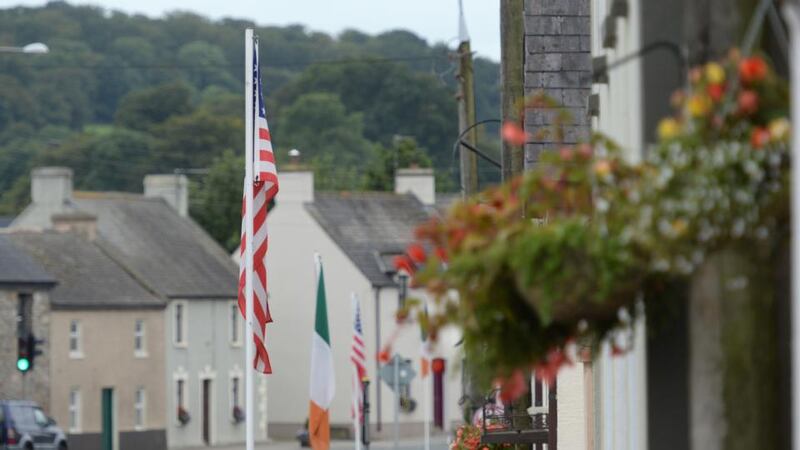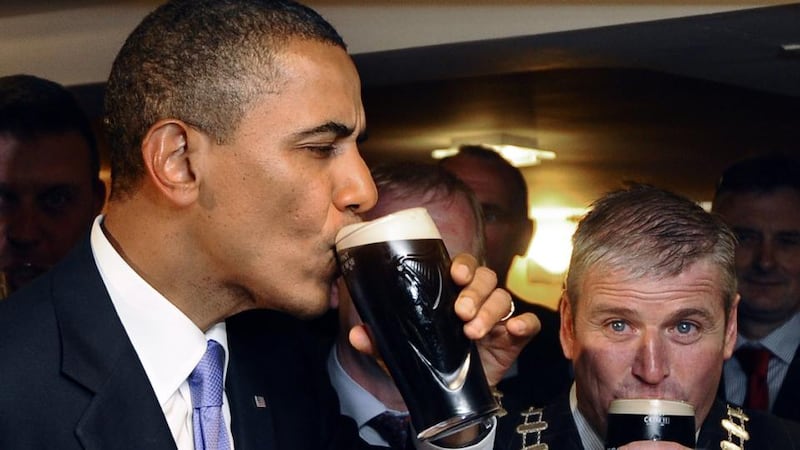The flags are still flying in Moneygall, Co Offaly – American flags, that is. Moneygall's one street is flanked with American and Irish flags, just as it was when US president Barack Obama and his wife Michelle came to visit in May 2011.
Some other things have remained unchanged since the presidential visit. For instance, the glasses that the American First Couple drank from in Ollie Hayes’s bar that day remain unwashed. They are on display in the bar, along with the €50 note that was used to pay for the drinks.
However, other things in Moneygall have changed dramatically. It now has the extensive Barack Obama Plaza, visible at the far end of its street. The plaza opened this summer and provides a kind of extension to Moneygall. The village has a population of about 300; the plaza sees thousands of people a day, who stop their journey on the M7 to buy petrol or eat at one of the many food outlets there. The bypass itself opened in 2010.


“If Obama hadn’t come, the place would be derelict at this stage, with the bypass and everything. Looking at other villages, they’re forgotten once the bypass comes,” says Marian Healy. She has lived on the street all her life. She is also the mother of Henry Healy, Obama’s eighth cousin.
“There was never a tourist in Moneygall before Obama came. They come and they’re gone in half an hour. Sure it’s something for us to look at. It’s people-watching.” In Healy’s view, the plaza is “there for the passing traffic. It wasn’t built for the village, but I’d say a lot of villagers are glad of it.”
There are at least two villagers on the street who are not glad of the plaza. Pat and Mary Bergin have run their post office, grocery and newsagents for 26 years.
“The plaza was the last nail in the coffin for us after the bypass,” says Pat. “We’ve gone as low as we can now. The Obama thing was only a blip. It masked to some extent the effect of the bypass. We got some passing trade out of the Obama thing, but the plaza has taken the last bit of passing trade. We’re down 50 per cent in the last two years.”
“We stopped doing tea and sandwiches once the plaza opened,” says Mary, “and even though the weather was lovely, it has been our worst ever summer for ice cream. How are we meant to reinvent ourselves as a business?”
“We’re a small shop,” adds Pat. “Where the money would be made is in what the passing trade would buy – ice cream, minerals, chocolates. You’d have the odd person in to do the Lotto, saying ‘We’re in Moneygall to see if we can win money.’ That’s all gone now. There was a GAA match in Dublin on Sunday and we had only one car all day. Without the post office, we probably would be closed.
“Small villages don’t have the means to support themselves without passing trade. From a business point-of-view, the village is dying.”
New gallery
Farther down the street, Jean Morgan doesn’t think the village is dying. On July 4th this year, when the village has its now-customary American festival celebrations, she opened her gallery and vintage shop, Revival. Opening a gallery anywhere these days is a challenge, and would seem even more so in a village of 300 people. She intends opening year round.
“Believe it or not, I would have opened here even without the Obama connection,” she says. “I’d been looking for a space in various villages nearby. I wanted to open this gallery, as we’re coming out of a recession and there’s a need for craft workers and artists to continue their work. This space was right.”
Morgan’s premises on the street used to be the village sweetshop. Its late owner, Mossy Hayes, had a pool table in the back and used to let the young people of the village in to use it. “It was the heart of the place. People hung out here. There was nothing for young people to do then, nowhere to go.”
Like others in the village, she mentions the draw of the plaza for the current generation of young people; their new hang-out place. “When the Obama thing fizzles out, the plaza might keep the village going. Since it opened, it has boosted curiosity in Moneygall.”
She may have opened on July 4th, but Morgan’s is one of very few businesses on the street that doesn’t display or stock any Obama-branded merchandise. “I didn’t want to make the place touristy,” she says.
On the other side of the street, it’s clear from the name alone – the Obama Cafe – that there are a lot of touristy things going on. It starts with the flower barrels outside, which are painted with slogans such as “Yes we can”. It continues inside with a life-sized image of Obama and a range of themed items, from table mats to clocks, plates and magnets.
“We opened in July 2011, after Obama’s visit,” says Paul Costello, who runs the 32-seater cafe with wife Annette, and who was born on the street. “Before that, there were no callers to Moneygall. You wouldn’t dream of putting a cafe here before. We saw an opportunity and we went for it. Obama’s visit put Moneygall on the map, no question of it.”
The Obama Cafe, which is open year round, has an eclectic line in decoration. The walls are painted with a mix of Celtic symbols and American icons, such as the Statue of Liberty. There's a big and slightly mystifying reproduction of a Titanic lifebelt, "so that people from London will feel at home", says Paul. (The doomed ship was registered in London.) There are American car-registration plates and German flags. "It's a modern building and we're trying to give a New York feel to it."
Costello considers the new plaza to be “the gateway to the village”. He’s hoping it won’t affect business. “A lot of people don’t like the filling-shop feel to the place. If they come down the street here, they’ll get a bit of culture in our cafe. It’s more homely.”
Mike Hayes owns the Liam Buckley car dealership on the street, where he has worked since he was 16. “When someone calls me about a car these days, they all know where Moneygall is now. Before, people wouldn’t have a clue where you were.”
He thinks the village has changed for the better since Obama’s visit.
“The place has changed a good bit since Obama was here. It was painted and tidied up, and the flowers are kept up. It does feel a bit different. There are a lot more strangers in the village now. The flags are there for the tourists. They take photos of them. The flags are changed every few months because they get a bit dirty and some of them are taken by people as souvenirs, although I don’t know how they get up at them.”
Obama cut-out
There’s a large sign outside Ollie Hayes’s bar, depicting Obama drinking a pint. Inside, there are many photographs from the visit and subsequent visits to the White House, as well as a cut-out of Obama.
“Our hen parties love getting photographed with Obama, but he’s getting a bit tatty now,” says Majella Hayes. The bar now regularly gets hen and stage parties at weekends; a recent hen party arrived in a Hummer.
Business, she says, was “huge all the year of the visit, but you’re not going to have that every day three years later”. They still get buses stopping regularly, and the bar serves food now, which it didn’t before 2011.
She doesn’t think the village has changed, despite the bypass and the plaza. “Bypasses are progress. The plaza is progress. It’s part of the village now.”
As for how long she thinks what other people on the street call “the Obama thing” will last, she says: “History will tell. John F Kennedy is dead a long time, and people are still going to see his home place in Wexford. So we’ll see.”
Next week: Meath Street, Dublin 8
We want to hear the stories of how a street in your locality has changed for worse or for better. Email thestreet@irishtimes.com with your memories and observations








